Where in the neuron is an action potential initially generated?
axon hillock
The depolarization phase of an action potential results from the opening of which channels?
voltage-gated Na+ channels
The repolarization phase of an action potential results from __________.
the opening of voltage-gated K+ channels
Hyperpolarization results from __________.
slow closing of voltage-gated K+ channels
What is the magnitude (amplitude) of an action potential?
100 mV
How is an action potential propagated along an axon?
An influx of sodium ions from the current action potential depolarizes the adjacent area.
Why does the action potential only move away from the cell body?
The areas that have had the action potential are refractory to a new action potential.
The velocity of the action potential is fastest in which of the following axons?
a small myelinated axon
The membranes of neurons at rest are very permeable to _____ but only slightly permeable to _____.
K+; Na+
(more K+ moves out of the cell than Na+ moves into the cell, helping to establish a negative resting membrane potential.)
During depolarization, which gradient(s) move(s) Na+ into the cell?
both the electrical and chemical gradients
(a positive ion is driven into the cell because the inside of the cell is negative compared to the outside of the cell, and Na+ is driven into the cell because the concentration of Na+ is greater outside the cell.)
What is the value for the resting membrane potential for most neurons?
–70 mV
(the resting membrane potential for neurons depends on the distribution of both Na+ and K+ across the cell membrane. The potential is closer to the equilibrium potential of K+ because the cell is more permeable to K+.)
The Na+–K+ pump actively transports both sodium and potassium ions across the membrane to compensate for their constant leakage. In which direction is each ion pumped?
Na+ is pumped out of the cell and K+ is pumped into the cell.
(Na+ is pumped out of the cell against its electrochemical gradient and K+ is pumped into the cell against its concentration gradient.)
The concentrations of which two ions are highest outside the cell.
Na+ and Cl–
(both Na+ and Cl– are in higher concentrations outside the cell)
During the action potential of a neuron, which ion is primarily crossing the membrane during the depolarization phase, and in which direction is the ion moving?
Na+ is entering the cell.
(During the depolarization phase of the action potential, open Na+ channels allow Na+ ions to diffuse into the cell. This inward movement of positive charge makes the membrane potential more positive (less negative). The depolarization phase is a positive feedback cycle where open Na+ channels cause depolarization, which in turn causes more voltage-gated Na+ channels to open.)
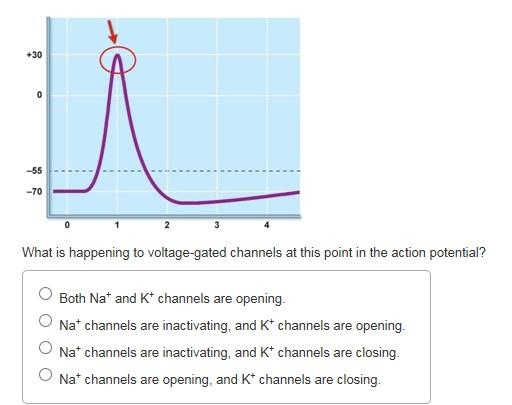
What is happening to voltage-gated channels at this point in the action potential?
Na+ channels are inactivating, and K+ channels are opening.
(As voltage-gated Na+ channels begin to inactivate, the membrane potential stops becoming more positive This marks the end of the depolarization phase of the action potential. Then, as voltage-gated K+ channels open, K+ ions rush out of the neuron, following their electrochemical gradient. This exit of positively-charged ions causes the interior of the cell to become more negative, repolarizing the membrane.)
During what part of the action potential do voltage-gated Na+ channels begin to inactivate (their inactivation gates close)?
at the end of the depolarization phase, as the membrane potential approaches its peak value
(Voltage-gated Na+ channels are opened by depolarization and then quickly inactivated. Once inactivated, these channels cannot pass Na+ ions. At the peak of the action potential, a large number of Na+ channels are open, but they are rapidly inactivating. As the action potential enters the repolarization phase, the number of open Na+ channels continues to decrease because more and more inactivation gates close. The number of inactivated Na+ channels is greatest towards the end of the repolarization phase.)
The repolarization phase of the action potential, where voltage becomes more negative after the +30mV peak, is caused primarily by __________.
K+ ions leaving the cell through voltage-gated channels
(The opening of voltage-gated K+ channels allows K+ ions to exit the cell, repolarizing the membrane. In other words, the exit of K+ ions makes the membrane potential more negative. K+ also exits through leakage channels during this phase because leakage channels are always active. However, most of the membrane permeability to K+ during this phase is due to voltage-gated channels. Voltage-gated K+ channels make the action potential more brief than it would otherwise be if only leakage channels were available to repolarize the membrane.)
During an action potential, hyperpolarization beyond (more negative to) the resting membrane potential is primarily due to __________.
K+ ions diffusing through voltage-gated channels
(The large number of voltage-gated K+ channels opening during the repolarization phase quickly makes the membrane potential more negative as positively-charged K+ ions leave the cell. K+ ions continue to leave through open channels as the membrane potential passes (becomes more negative than) the resting potential. This hyperpolarization phase of the action potential is therefore due to K+ ions diffusing through voltage-gated K+ channels. The membrane potential remains more negative than the resting potential until voltage-gated K+ channels close. This period of hyperpolarization is important in relieving voltage-gated Na+ channels from inactivation, readying them for another action potential.)
During the hyperpolarization phase of the action potential, when the membrane potential is more negative than the resting membrane potential, what happens to voltage-gated ion channels?
K+ channels close. Na+ channels go from an inactivated state to a closed state.
(Voltage-gated K+ channels are opened by depolarization. This means that as the membrane potential repolarizes and then hyperpolarizes, these K+ channels close. With the closing of voltage-gated K+ channels, the membrane potential returns to the resting membrane potential via leakage channel activity. Resetting voltage-gated Na+ channels to the closed (but not inactivated) state prepares them for the next action potential.)
Tetraethylammonium (TEA) blocks voltage-gated K+ channels such that K+ cannot pass even when the channels are open. However, TEA leaves K+ leakage channels largely unaffected. How would you expect the action potential to change if you treated a neuron with TEA?
The action potential would depolarize as usual, but the repolarization phase would take longer, causing the action potential to be more broad in time.
(The passage of K+ ions through open voltage-gated K+ channels is an important component of the repolarization phase of the action potential. However, repolarization would still occur (albeit more slowly) in the presence of TEA. Once voltage-gated Na+ channels open during the depolarization phase, those same Na+ channels quickly inactivate. In other words, open Na+ channels inevitably inactivate regardless of whether K+ channels open or not. This means that the depolarization phase of the action potential stops on its own. Once Na+ channels inactivate, the membrane potential is set by other open channels. If voltage-gated K+ channels are blocked by TEA, then the membrane will be (slowly) set, by leakage channels, to the resting membrane potential.)
The diffusion of what ion, across the neuronal membrane, is responsible for the local currents that depolarize regions of the axon to threshold?
Na+ (sodium)
An action potential in one segment of axon causes adjacent sections of axon membrane to reach threshold through what mechanism?
the generation of local currents
During action potential propagation in an unmyelinated axon, why doesn't the action potential suddenly "double back" and start propagating in the opposite direction?
The previous axonal segment is in the refractory period.
In a myelinated axon, how do the nodes of Ranvier differ from other segments of the same axon?
The nodes are more permeable to ions.
Where are action potentials regenerated as they propagate along a myelinated axon?
at the nodes of Ranvier
How do action potential propagation speeds compare in myelinated and unmyelinated axons?
Propagation is faster in myelinated axons.
The node-to-node "jumping" regeneration of an action potential along a myelinated axon is called __________.
saltatory conduction
The myelin on myelinated neurons can be degraded or destroyed in diseases such as multiple sclerosis-a process called demyelination. If a myelinated neuron was affected by demyelination, how would this affect action potentials in that neuron?
The speed of action potential propagation would be slower.
Which of the following best describes the Na+ and K+ concentrations across a neuron's plasma membrane?
The Na+ concentration is higher outside the cell compared to inside. The K+ concentration is higher inside the cell compared to outside.
What is the major role of the Na+-K+ pump in maintaining the resting membrane potential?
maintaining the concentration gradients for Na+ and K+ across the cell membrane
Which of the following is the clearest example of a neuronal membrane's selective permeability?
K+ ions can diffuse across the membrane more easily than Na+ ions.
Which of the following would increase the membrane permeability to K+?
more K+ leakage channels
Suppose a drug is developed that blocks K+ leakage channels. The drug prevents ions from passing through those channels. If this drug was applied to a neuron, what would be the most immediate effect on that neuron?
The resting membrane potential would become less negative (more positive).
Imagine you changed the concentration of K+ outside a neuron such that the resting membrane potential changed to -80 mV (from the normal resting value of -70 mV). What have you changed?
the electrical gradient for K+ and the concentration gradient for K+
What is the electrochemical gradient of an ion?
the sum of the electrical and concentration gradients for that ion
Hypothetically, what would be the most immediate effect of doubling the number of Na+ leakage channels in the plasma membrane?
The resting membrane potential would become less negative (more positive).
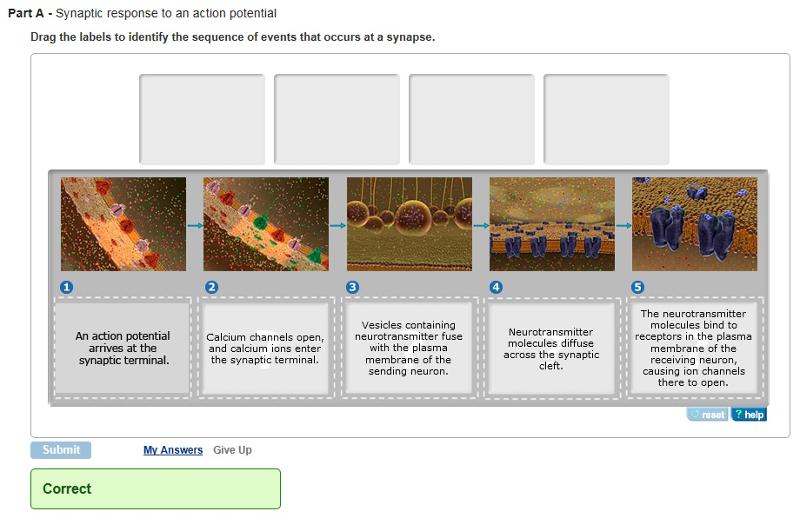
Synaptic response to an action potential
Drag the labels to identify the sequence of events that occurs at a synapse.
1. An action potential arrives at the synaptic terminal.
2. Calcium channels open, and calcium ions enter the synaptic terminal.
3. Vesicles containing neurotransmitter fuse with the plasma membrane of the sending neuron.
4. Neurotransmitter molecules diffuse across the synaptic cleft.
5. The neurotransmitter molecules bind to receptors in the plasma membrane of the receiving neuron, causing ion channels there to open.
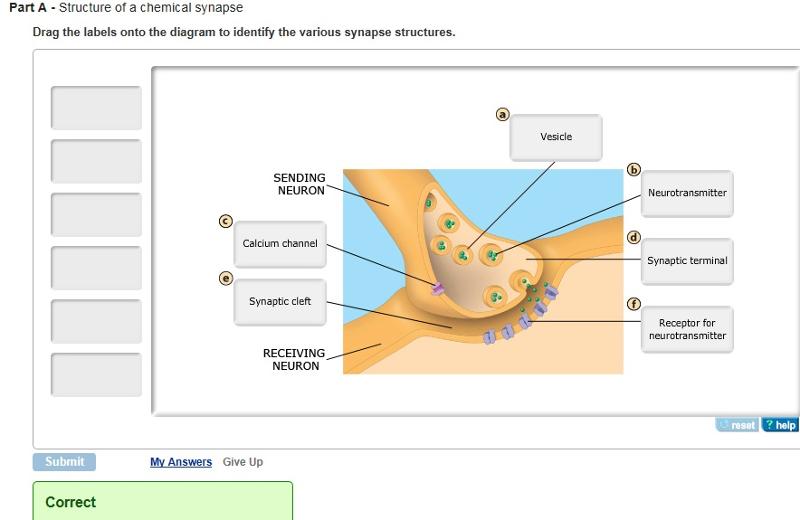
How Synapses Work
see diagram
The small space between the sending neuron and the receiving neuron is the
synaptic cleft.
A molecule that carries information across a synaptic cleft is a
neurotransmitter.
When calcium ions enter the synaptic terminal,
they cause vesicles containing neurotransmitter molecules to fuse to the plasma membrane of the sending neuron.
When neurotransmitter molecules bind to receptors in the plasma membrane of the receiving neuron,
ion channels in the plasma membrane of the receiving neuron open.
If a signal from a sending neuron makes the receiving neuron more negative inside,
the receiving neuron is less likely to generate an action potential.
Arrange these parts in order, from left to right, of a successful direct depolarization path within one neuron.
- axon
- axon hillock
- cell body
- dendrite
- presynaptic terminal
1. dendrite
2. cell body
3. axon hillock
4. axon
5. presynaptic terminal
Which of the following best characterizes depolarization?
small consecutive steps of Na+ penetration into the axon along its length
Click and drag the labels to the correct structure at the chemical synapse.
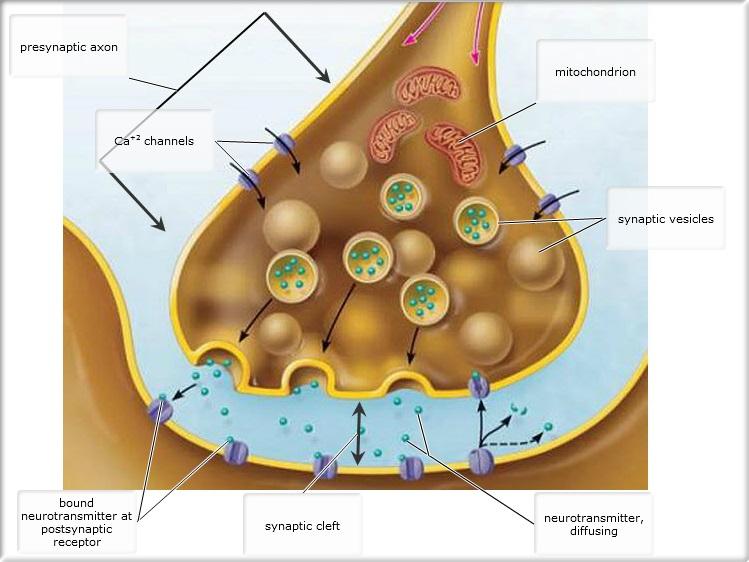
see diagram
When an action potential arrives at the end of the axon terminal, a series of events take place that result in the release of neurotransmitter from the presynaptic axon. Select the answer that correctly describes the primary stimulus for vesicles to move towards the cell membrane and eventually release their contents.
voltage-gated membrane channels open, and Ca+2 enters the cytoplasm, increasing intracellular calcium
Which statement best describes exocytosis?
Membrane organelles fuse with the membrane and release contents out of the cell.
What conditions will increase the diffusion of molecules, such as neurotransmitters?
An increase in the amount of neurotransmitter exocytized by the presynaptic axon
If the membrane of a postsynaptic dendrite is setting up a graded potential, what must have happened after neurotransmitter was released by the presynaptic terminal?
bound at postsynaptic receptors to open postsynaptic ion channels.
Drag and drop the descriptive labels of events into the correct sequence at the chemical synapse.
1. Action potential sweeps down presynaptic axon
2. Calcium channels open in axon terminal.
3. Synaptic vesicles fuse and exocytize neurotransmitter
4. Diffusion of neurotransmitter into extracellular fluid separating two neuron's membranes
5. Graded potential at postsynaptic membrane
Which best represents synaptic transmission?
presynaptic axon to synapse to dendrite or postsynaptic cell body
Predict the possible effect of a drug that totally blocks the neurotransmitter receptor on the postsynaptic membrane.
For example, curare is a neurotoxin used by several South American cultures. The primary effect of curare is that acetylcholine, a major neuromuscular neurotransmitter, cannot bind at its receptor because curare is blocking it. Predict the possible effects of curare on the postsynaptic membrane and muscle.
Local graded potentials and action potential transmission is blocked and there is no response by the postsynaptic cell, the muscle.
In a synapse, neurotransmitters are stored in vesicles located in the __________.
presynaptic neuron
An action potential releases neurotransmitter from a neuron by opening which of the following channels?
voltage-gated Ca2+ channels
Binding of a neurotransmitter to its receptors opens __________ channels on the __________ membrane.
chemically gated; postsynaptic
Binding of the neurotransmitter to its receptor causes the membrane to __________.
either depolarize or hyperpolarize
The mechanism by which the neurotransmitter is returned to a presynaptic neuron’s axon terminal is specific for each neurotransmitter. Which of the following neurotransmitters is broken down by an enzyme before being returned?
acetylcholine
A postsynaptic cell can be a neuron, a muscle cell, or a secretory cell. What is an example of a presynaptic cell?
a neuron
Which component has a role in the postsynaptic cell during synaptic activity?
chemically gated channels
What is the role of calcium in synaptic activity?
Calcium influx into the synaptic terminal causes vesicle fusion.
What is the direct role of neurotransmitter at a chemical synapse?
Neurotransmitter binds to receptors on the postsynaptic cell membrane and allows ions to diffuse across the membrane.
Neurotransmitter is released from presynaptic neurons through what mechanism?
exocytosis
What type of channel on the postsynaptic membrane binds neurotransmitter?
a chemically gated channel
In addition to diffusion, what are two other mechanisms that terminate neurotransmitter activity?
reuptake and degradation
Events that occur during synaptic activity are listed here, but they are arranged in an incorrect order. Choose the correct order of these events below. (a) Voltage-gated calcium channels open (b) Neurotransmitter binds to receptors (c) Action potential arrives at axon terminal (d) Neurotransmitter is removed from the synaptic cleft (e) Neurotransmitter released into synaptic cleft (f) Graded potential generated in postsynaptic cell
(c) Action potential arrives at axon terminal
(a) Voltage-gated
calcium channels open
(e) Neurotransmitter released into
synaptic cleft
(b) Neurotransmitter binds to receptors (f)
Graded potential generated in postsynaptic cell
(d)
Neurotransmitter is removed from the synaptic cleft
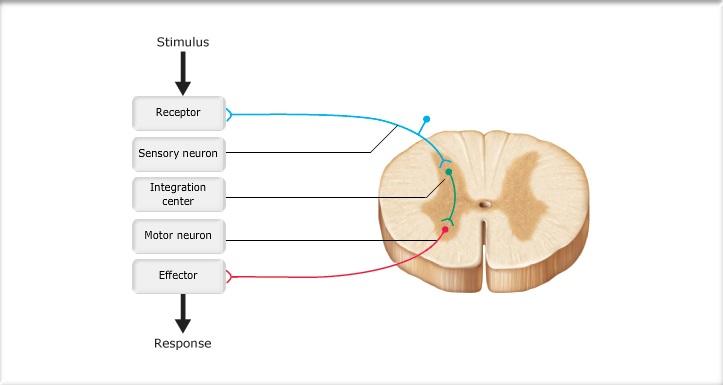
stimulus
receptor
sensory neuron
integration center
motor neuron
effector
response
see diagram